Organisational Change Management .
VerifiedAdded on 2023/05/28
|12
|3294
|462
AI Summary
This article discusses the implementation of organizational change management in ABC Groups of Hospitals. It covers the outcomes, barriers, change theory, change agents, and implications of the change program. The ADKAR model is suggested as a change theory for the hospital. The article also highlights the positive and negative implications of the change program and the importance of evaluating its effectiveness after implementation.
Contribute Materials
Your contribution can guide someone’s learning journey. Share your
documents today.
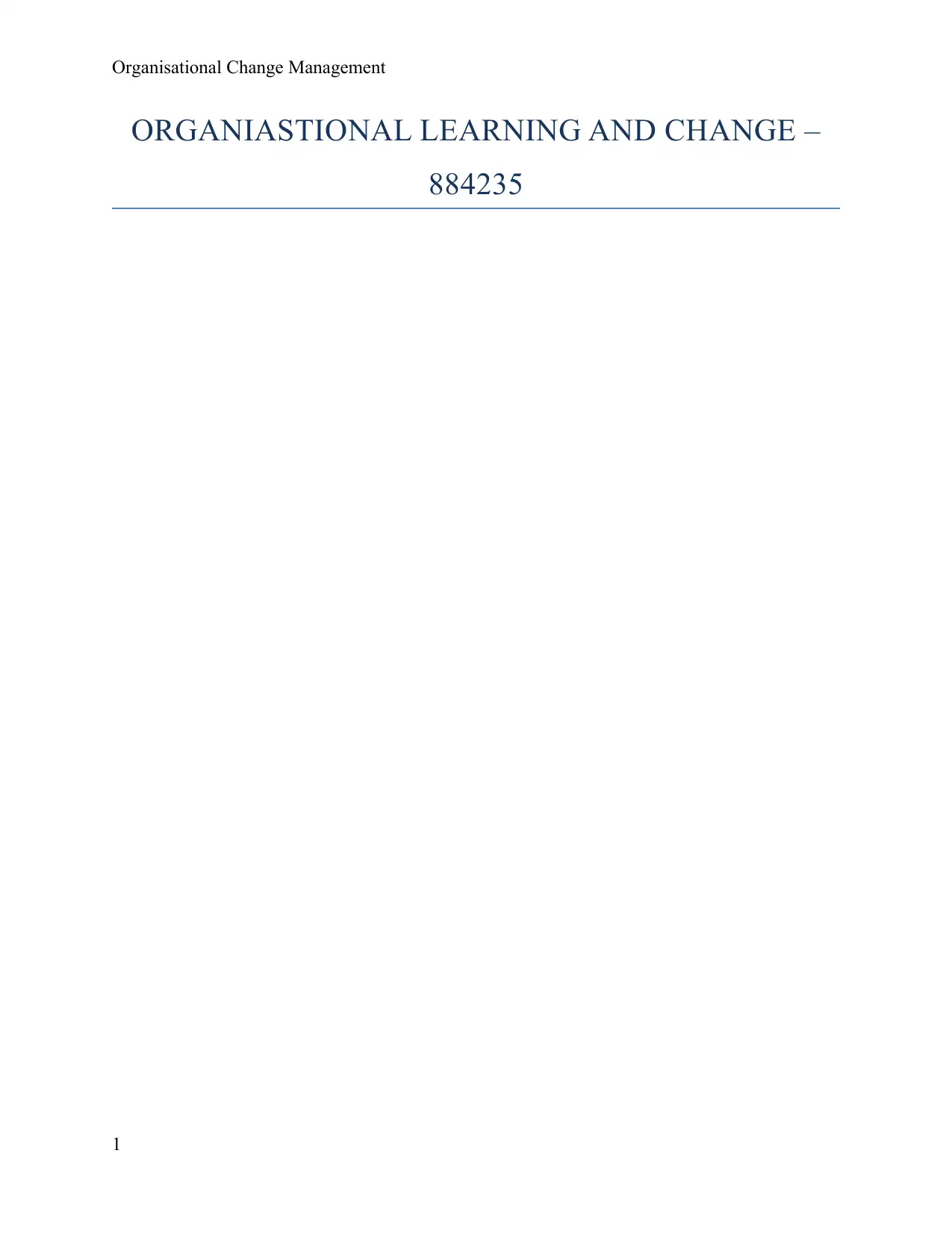
Organisational Change Management
ORGANIASTIONAL LEARNING AND CHANGE –
884235
1
ORGANIASTIONAL LEARNING AND CHANGE –
884235
1
Secure Best Marks with AI Grader
Need help grading? Try our AI Grader for instant feedback on your assignments.
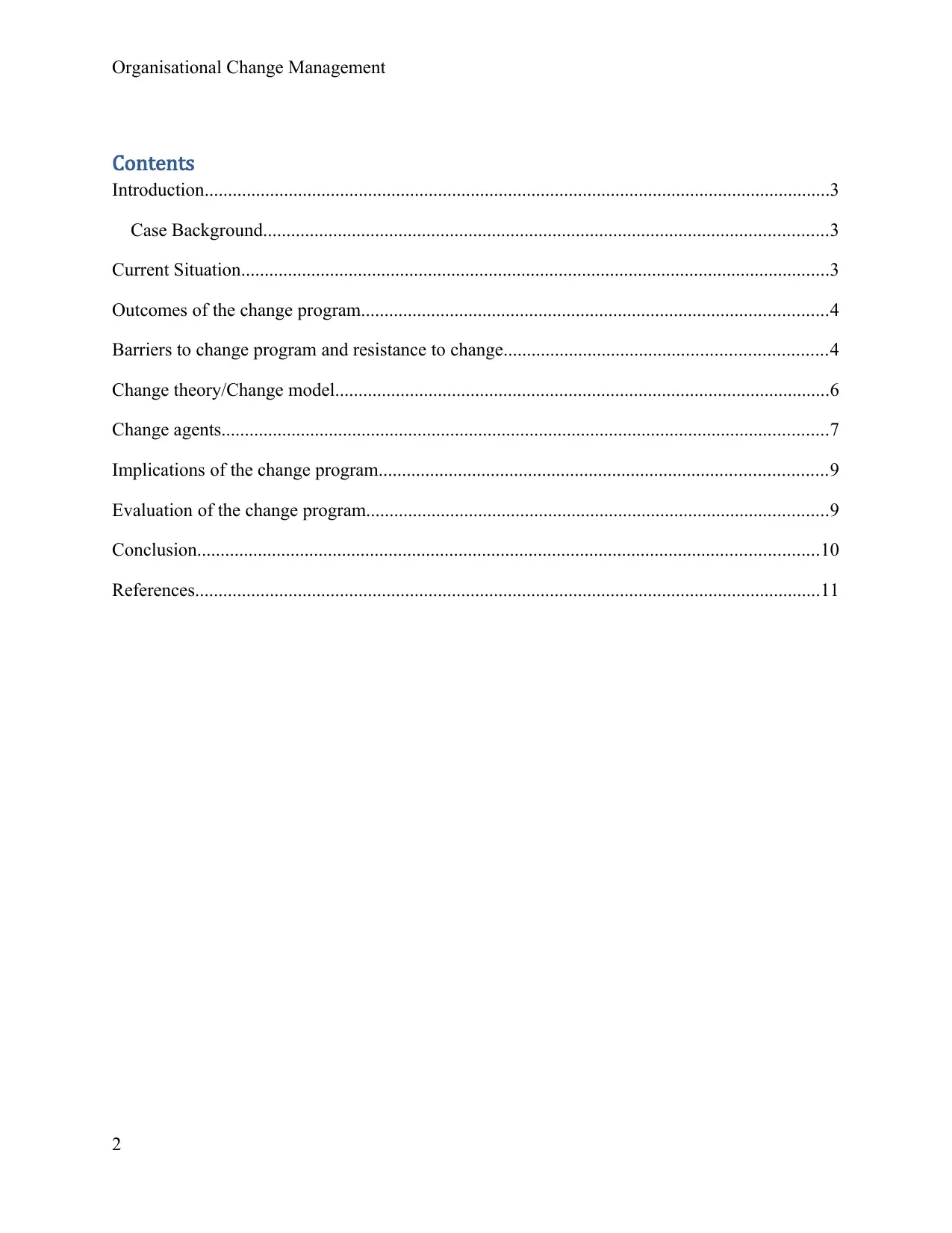
Organisational Change Management
Contents
Introduction......................................................................................................................................3
Case Background.........................................................................................................................3
Current Situation..............................................................................................................................3
Outcomes of the change program....................................................................................................4
Barriers to change program and resistance to change.....................................................................4
Change theory/Change model..........................................................................................................6
Change agents..................................................................................................................................7
Implications of the change program................................................................................................9
Evaluation of the change program...................................................................................................9
Conclusion.....................................................................................................................................10
References......................................................................................................................................11
2
Contents
Introduction......................................................................................................................................3
Case Background.........................................................................................................................3
Current Situation..............................................................................................................................3
Outcomes of the change program....................................................................................................4
Barriers to change program and resistance to change.....................................................................4
Change theory/Change model..........................................................................................................6
Change agents..................................................................................................................................7
Implications of the change program................................................................................................9
Evaluation of the change program...................................................................................................9
Conclusion.....................................................................................................................................10
References......................................................................................................................................11
2
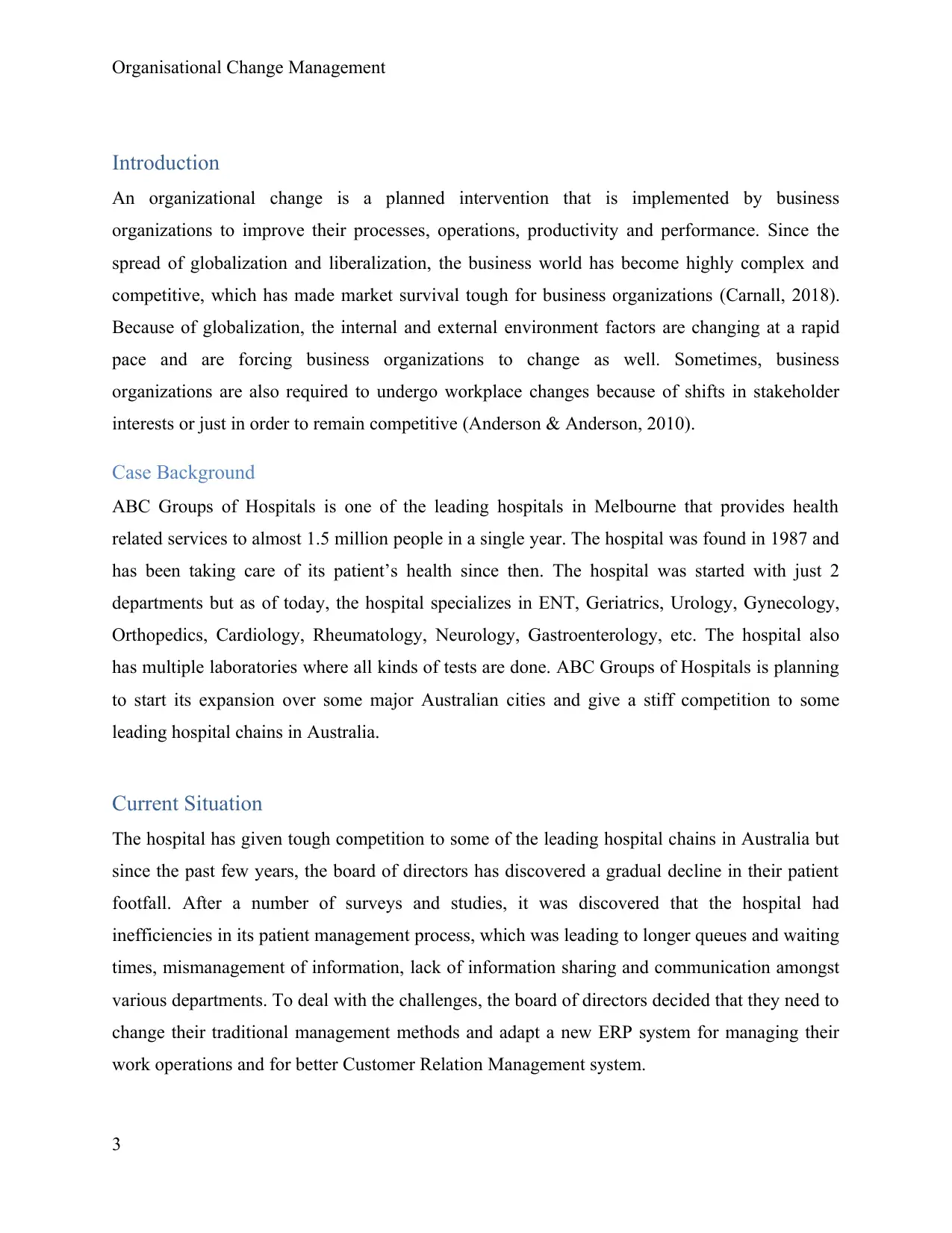
Organisational Change Management
Introduction
An organizational change is a planned intervention that is implemented by business
organizations to improve their processes, operations, productivity and performance. Since the
spread of globalization and liberalization, the business world has become highly complex and
competitive, which has made market survival tough for business organizations (Carnall, 2018).
Because of globalization, the internal and external environment factors are changing at a rapid
pace and are forcing business organizations to change as well. Sometimes, business
organizations are also required to undergo workplace changes because of shifts in stakeholder
interests or just in order to remain competitive (Anderson & Anderson, 2010).
Case Background
ABC Groups of Hospitals is one of the leading hospitals in Melbourne that provides health
related services to almost 1.5 million people in a single year. The hospital was found in 1987 and
has been taking care of its patient’s health since then. The hospital was started with just 2
departments but as of today, the hospital specializes in ENT, Geriatrics, Urology, Gynecology,
Orthopedics, Cardiology, Rheumatology, Neurology, Gastroenterology, etc. The hospital also
has multiple laboratories where all kinds of tests are done. ABC Groups of Hospitals is planning
to start its expansion over some major Australian cities and give a stiff competition to some
leading hospital chains in Australia.
Current Situation
The hospital has given tough competition to some of the leading hospital chains in Australia but
since the past few years, the board of directors has discovered a gradual decline in their patient
footfall. After a number of surveys and studies, it was discovered that the hospital had
inefficiencies in its patient management process, which was leading to longer queues and waiting
times, mismanagement of information, lack of information sharing and communication amongst
various departments. To deal with the challenges, the board of directors decided that they need to
change their traditional management methods and adapt a new ERP system for managing their
work operations and for better Customer Relation Management system.
3
Introduction
An organizational change is a planned intervention that is implemented by business
organizations to improve their processes, operations, productivity and performance. Since the
spread of globalization and liberalization, the business world has become highly complex and
competitive, which has made market survival tough for business organizations (Carnall, 2018).
Because of globalization, the internal and external environment factors are changing at a rapid
pace and are forcing business organizations to change as well. Sometimes, business
organizations are also required to undergo workplace changes because of shifts in stakeholder
interests or just in order to remain competitive (Anderson & Anderson, 2010).
Case Background
ABC Groups of Hospitals is one of the leading hospitals in Melbourne that provides health
related services to almost 1.5 million people in a single year. The hospital was found in 1987 and
has been taking care of its patient’s health since then. The hospital was started with just 2
departments but as of today, the hospital specializes in ENT, Geriatrics, Urology, Gynecology,
Orthopedics, Cardiology, Rheumatology, Neurology, Gastroenterology, etc. The hospital also
has multiple laboratories where all kinds of tests are done. ABC Groups of Hospitals is planning
to start its expansion over some major Australian cities and give a stiff competition to some
leading hospital chains in Australia.
Current Situation
The hospital has given tough competition to some of the leading hospital chains in Australia but
since the past few years, the board of directors has discovered a gradual decline in their patient
footfall. After a number of surveys and studies, it was discovered that the hospital had
inefficiencies in its patient management process, which was leading to longer queues and waiting
times, mismanagement of information, lack of information sharing and communication amongst
various departments. To deal with the challenges, the board of directors decided that they need to
change their traditional management methods and adapt a new ERP system for managing their
work operations and for better Customer Relation Management system.
3
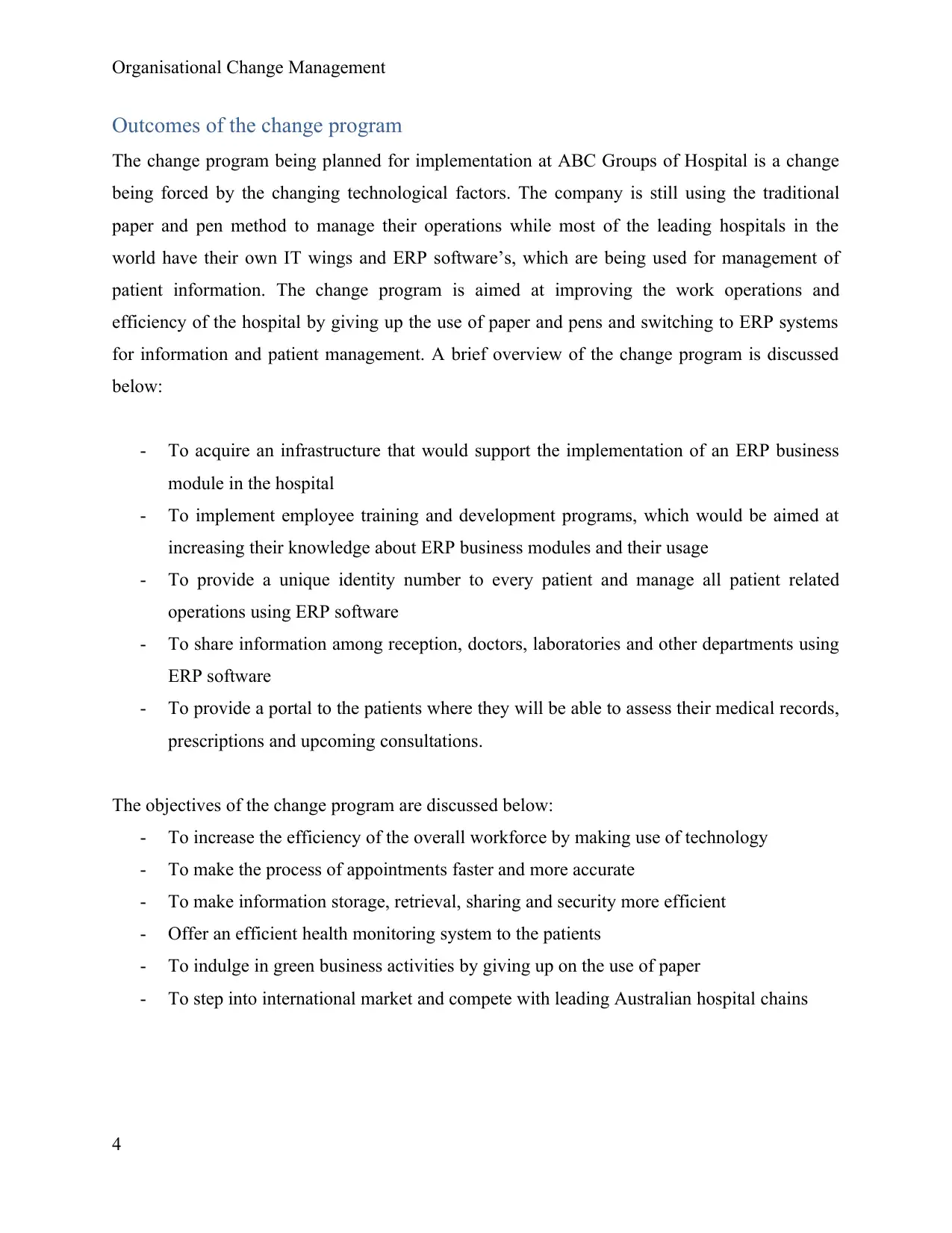
Organisational Change Management
Outcomes of the change program
The change program being planned for implementation at ABC Groups of Hospital is a change
being forced by the changing technological factors. The company is still using the traditional
paper and pen method to manage their operations while most of the leading hospitals in the
world have their own IT wings and ERP software’s, which are being used for management of
patient information. The change program is aimed at improving the work operations and
efficiency of the hospital by giving up the use of paper and pens and switching to ERP systems
for information and patient management. A brief overview of the change program is discussed
below:
- To acquire an infrastructure that would support the implementation of an ERP business
module in the hospital
- To implement employee training and development programs, which would be aimed at
increasing their knowledge about ERP business modules and their usage
- To provide a unique identity number to every patient and manage all patient related
operations using ERP software
- To share information among reception, doctors, laboratories and other departments using
ERP software
- To provide a portal to the patients where they will be able to assess their medical records,
prescriptions and upcoming consultations.
The objectives of the change program are discussed below:
- To increase the efficiency of the overall workforce by making use of technology
- To make the process of appointments faster and more accurate
- To make information storage, retrieval, sharing and security more efficient
- Offer an efficient health monitoring system to the patients
- To indulge in green business activities by giving up on the use of paper
- To step into international market and compete with leading Australian hospital chains
4
Outcomes of the change program
The change program being planned for implementation at ABC Groups of Hospital is a change
being forced by the changing technological factors. The company is still using the traditional
paper and pen method to manage their operations while most of the leading hospitals in the
world have their own IT wings and ERP software’s, which are being used for management of
patient information. The change program is aimed at improving the work operations and
efficiency of the hospital by giving up the use of paper and pens and switching to ERP systems
for information and patient management. A brief overview of the change program is discussed
below:
- To acquire an infrastructure that would support the implementation of an ERP business
module in the hospital
- To implement employee training and development programs, which would be aimed at
increasing their knowledge about ERP business modules and their usage
- To provide a unique identity number to every patient and manage all patient related
operations using ERP software
- To share information among reception, doctors, laboratories and other departments using
ERP software
- To provide a portal to the patients where they will be able to assess their medical records,
prescriptions and upcoming consultations.
The objectives of the change program are discussed below:
- To increase the efficiency of the overall workforce by making use of technology
- To make the process of appointments faster and more accurate
- To make information storage, retrieval, sharing and security more efficient
- Offer an efficient health monitoring system to the patients
- To indulge in green business activities by giving up on the use of paper
- To step into international market and compete with leading Australian hospital chains
4
Secure Best Marks with AI Grader
Need help grading? Try our AI Grader for instant feedback on your assignments.
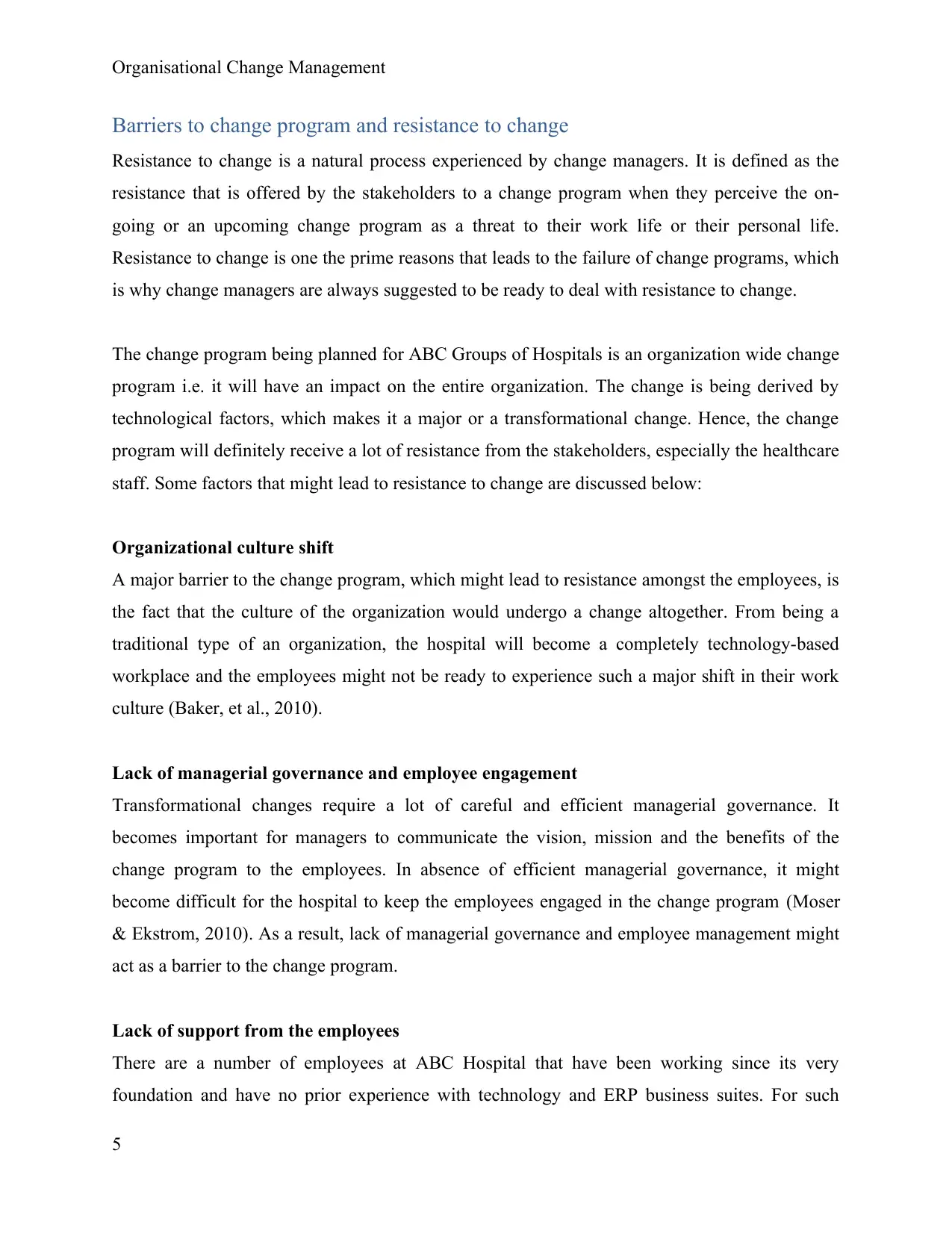
Organisational Change Management
Barriers to change program and resistance to change
Resistance to change is a natural process experienced by change managers. It is defined as the
resistance that is offered by the stakeholders to a change program when they perceive the on-
going or an upcoming change program as a threat to their work life or their personal life.
Resistance to change is one the prime reasons that leads to the failure of change programs, which
is why change managers are always suggested to be ready to deal with resistance to change.
The change program being planned for ABC Groups of Hospitals is an organization wide change
program i.e. it will have an impact on the entire organization. The change is being derived by
technological factors, which makes it a major or a transformational change. Hence, the change
program will definitely receive a lot of resistance from the stakeholders, especially the healthcare
staff. Some factors that might lead to resistance to change are discussed below:
Organizational culture shift
A major barrier to the change program, which might lead to resistance amongst the employees, is
the fact that the culture of the organization would undergo a change altogether. From being a
traditional type of an organization, the hospital will become a completely technology-based
workplace and the employees might not be ready to experience such a major shift in their work
culture (Baker, et al., 2010).
Lack of managerial governance and employee engagement
Transformational changes require a lot of careful and efficient managerial governance. It
becomes important for managers to communicate the vision, mission and the benefits of the
change program to the employees. In absence of efficient managerial governance, it might
become difficult for the hospital to keep the employees engaged in the change program (Moser
& Ekstrom, 2010). As a result, lack of managerial governance and employee management might
act as a barrier to the change program.
Lack of support from the employees
There are a number of employees at ABC Hospital that have been working since its very
foundation and have no prior experience with technology and ERP business suites. For such
5
Barriers to change program and resistance to change
Resistance to change is a natural process experienced by change managers. It is defined as the
resistance that is offered by the stakeholders to a change program when they perceive the on-
going or an upcoming change program as a threat to their work life or their personal life.
Resistance to change is one the prime reasons that leads to the failure of change programs, which
is why change managers are always suggested to be ready to deal with resistance to change.
The change program being planned for ABC Groups of Hospitals is an organization wide change
program i.e. it will have an impact on the entire organization. The change is being derived by
technological factors, which makes it a major or a transformational change. Hence, the change
program will definitely receive a lot of resistance from the stakeholders, especially the healthcare
staff. Some factors that might lead to resistance to change are discussed below:
Organizational culture shift
A major barrier to the change program, which might lead to resistance amongst the employees, is
the fact that the culture of the organization would undergo a change altogether. From being a
traditional type of an organization, the hospital will become a completely technology-based
workplace and the employees might not be ready to experience such a major shift in their work
culture (Baker, et al., 2010).
Lack of managerial governance and employee engagement
Transformational changes require a lot of careful and efficient managerial governance. It
becomes important for managers to communicate the vision, mission and the benefits of the
change program to the employees. In absence of efficient managerial governance, it might
become difficult for the hospital to keep the employees engaged in the change program (Moser
& Ekstrom, 2010). As a result, lack of managerial governance and employee management might
act as a barrier to the change program.
Lack of support from the employees
There are a number of employees at ABC Hospital that have been working since its very
foundation and have no prior experience with technology and ERP business suites. For such
5
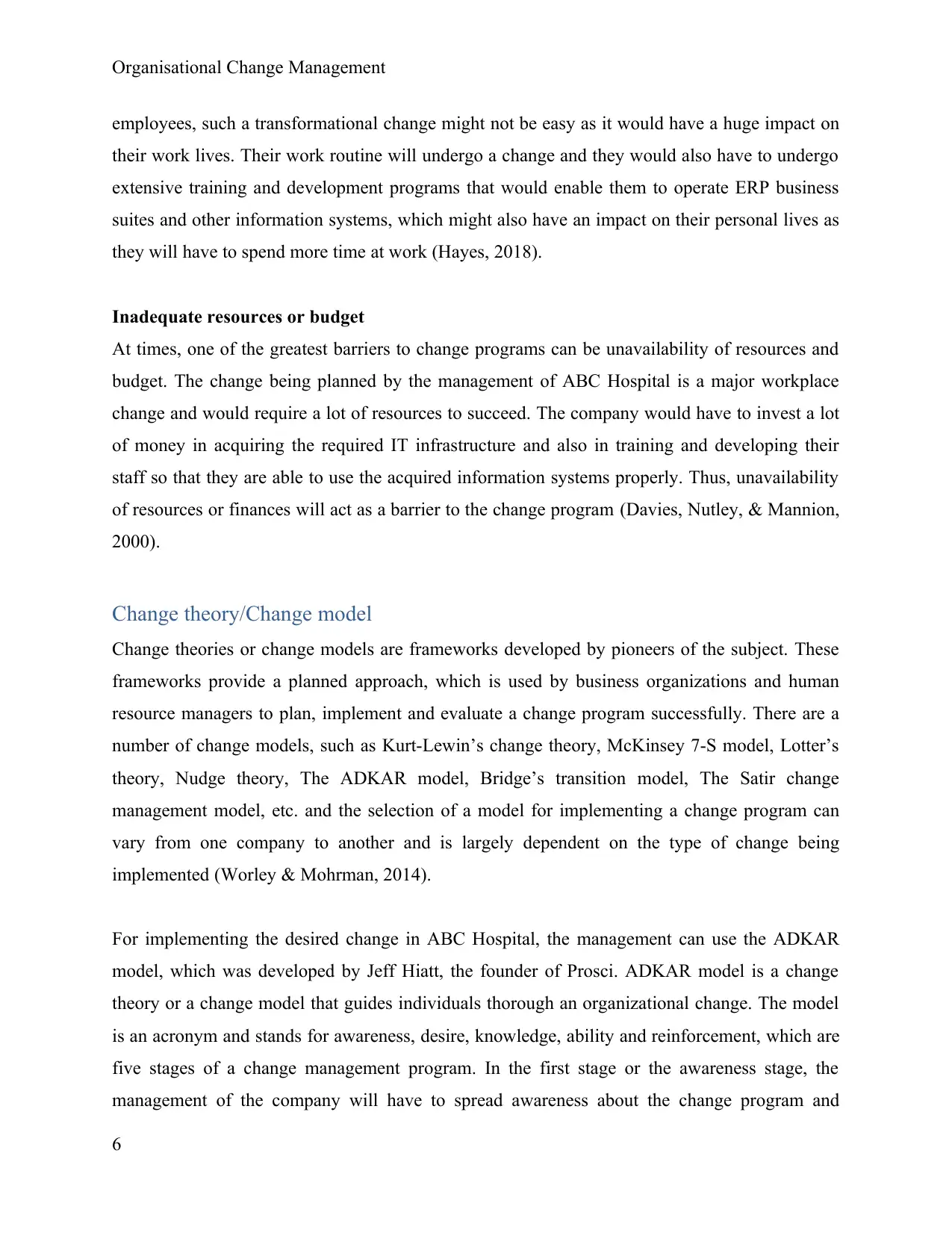
Organisational Change Management
employees, such a transformational change might not be easy as it would have a huge impact on
their work lives. Their work routine will undergo a change and they would also have to undergo
extensive training and development programs that would enable them to operate ERP business
suites and other information systems, which might also have an impact on their personal lives as
they will have to spend more time at work (Hayes, 2018).
Inadequate resources or budget
At times, one of the greatest barriers to change programs can be unavailability of resources and
budget. The change being planned by the management of ABC Hospital is a major workplace
change and would require a lot of resources to succeed. The company would have to invest a lot
of money in acquiring the required IT infrastructure and also in training and developing their
staff so that they are able to use the acquired information systems properly. Thus, unavailability
of resources or finances will act as a barrier to the change program (Davies, Nutley, & Mannion,
2000).
Change theory/Change model
Change theories or change models are frameworks developed by pioneers of the subject. These
frameworks provide a planned approach, which is used by business organizations and human
resource managers to plan, implement and evaluate a change program successfully. There are a
number of change models, such as Kurt-Lewin’s change theory, McKinsey 7-S model, Lotter’s
theory, Nudge theory, The ADKAR model, Bridge’s transition model, The Satir change
management model, etc. and the selection of a model for implementing a change program can
vary from one company to another and is largely dependent on the type of change being
implemented (Worley & Mohrman, 2014).
For implementing the desired change in ABC Hospital, the management can use the ADKAR
model, which was developed by Jeff Hiatt, the founder of Prosci. ADKAR model is a change
theory or a change model that guides individuals thorough an organizational change. The model
is an acronym and stands for awareness, desire, knowledge, ability and reinforcement, which are
five stages of a change management program. In the first stage or the awareness stage, the
management of the company will have to spread awareness about the change program and
6
employees, such a transformational change might not be easy as it would have a huge impact on
their work lives. Their work routine will undergo a change and they would also have to undergo
extensive training and development programs that would enable them to operate ERP business
suites and other information systems, which might also have an impact on their personal lives as
they will have to spend more time at work (Hayes, 2018).
Inadequate resources or budget
At times, one of the greatest barriers to change programs can be unavailability of resources and
budget. The change being planned by the management of ABC Hospital is a major workplace
change and would require a lot of resources to succeed. The company would have to invest a lot
of money in acquiring the required IT infrastructure and also in training and developing their
staff so that they are able to use the acquired information systems properly. Thus, unavailability
of resources or finances will act as a barrier to the change program (Davies, Nutley, & Mannion,
2000).
Change theory/Change model
Change theories or change models are frameworks developed by pioneers of the subject. These
frameworks provide a planned approach, which is used by business organizations and human
resource managers to plan, implement and evaluate a change program successfully. There are a
number of change models, such as Kurt-Lewin’s change theory, McKinsey 7-S model, Lotter’s
theory, Nudge theory, The ADKAR model, Bridge’s transition model, The Satir change
management model, etc. and the selection of a model for implementing a change program can
vary from one company to another and is largely dependent on the type of change being
implemented (Worley & Mohrman, 2014).
For implementing the desired change in ABC Hospital, the management can use the ADKAR
model, which was developed by Jeff Hiatt, the founder of Prosci. ADKAR model is a change
theory or a change model that guides individuals thorough an organizational change. The model
is an acronym and stands for awareness, desire, knowledge, ability and reinforcement, which are
five stages of a change management program. In the first stage or the awareness stage, the
management of the company will have to spread awareness about the change program and
6
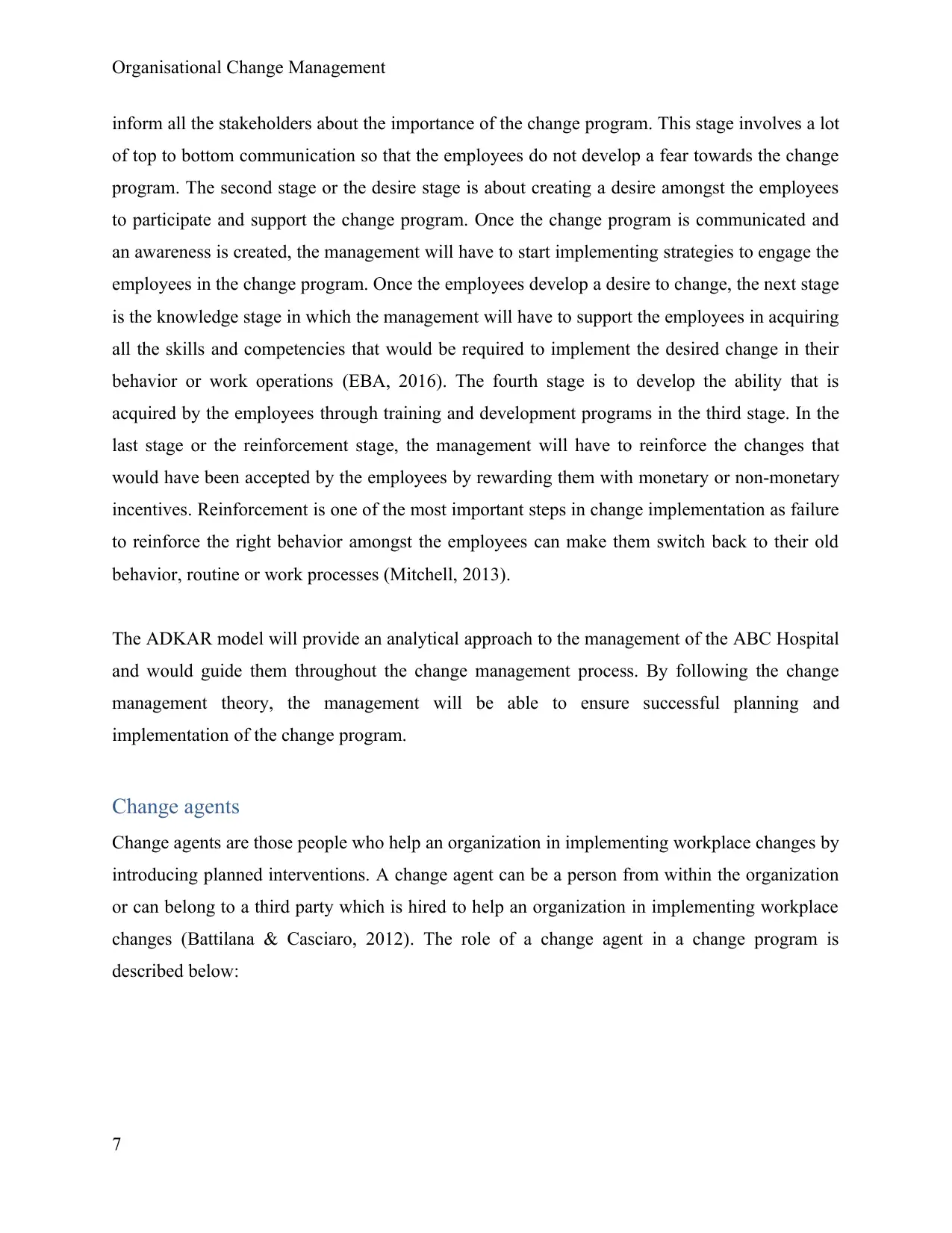
Organisational Change Management
inform all the stakeholders about the importance of the change program. This stage involves a lot
of top to bottom communication so that the employees do not develop a fear towards the change
program. The second stage or the desire stage is about creating a desire amongst the employees
to participate and support the change program. Once the change program is communicated and
an awareness is created, the management will have to start implementing strategies to engage the
employees in the change program. Once the employees develop a desire to change, the next stage
is the knowledge stage in which the management will have to support the employees in acquiring
all the skills and competencies that would be required to implement the desired change in their
behavior or work operations (EBA, 2016). The fourth stage is to develop the ability that is
acquired by the employees through training and development programs in the third stage. In the
last stage or the reinforcement stage, the management will have to reinforce the changes that
would have been accepted by the employees by rewarding them with monetary or non-monetary
incentives. Reinforcement is one of the most important steps in change implementation as failure
to reinforce the right behavior amongst the employees can make them switch back to their old
behavior, routine or work processes (Mitchell, 2013).
The ADKAR model will provide an analytical approach to the management of the ABC Hospital
and would guide them throughout the change management process. By following the change
management theory, the management will be able to ensure successful planning and
implementation of the change program.
Change agents
Change agents are those people who help an organization in implementing workplace changes by
introducing planned interventions. A change agent can be a person from within the organization
or can belong to a third party which is hired to help an organization in implementing workplace
changes (Battilana & Casciaro, 2012). The role of a change agent in a change program is
described below:
7
inform all the stakeholders about the importance of the change program. This stage involves a lot
of top to bottom communication so that the employees do not develop a fear towards the change
program. The second stage or the desire stage is about creating a desire amongst the employees
to participate and support the change program. Once the change program is communicated and
an awareness is created, the management will have to start implementing strategies to engage the
employees in the change program. Once the employees develop a desire to change, the next stage
is the knowledge stage in which the management will have to support the employees in acquiring
all the skills and competencies that would be required to implement the desired change in their
behavior or work operations (EBA, 2016). The fourth stage is to develop the ability that is
acquired by the employees through training and development programs in the third stage. In the
last stage or the reinforcement stage, the management will have to reinforce the changes that
would have been accepted by the employees by rewarding them with monetary or non-monetary
incentives. Reinforcement is one of the most important steps in change implementation as failure
to reinforce the right behavior amongst the employees can make them switch back to their old
behavior, routine or work processes (Mitchell, 2013).
The ADKAR model will provide an analytical approach to the management of the ABC Hospital
and would guide them throughout the change management process. By following the change
management theory, the management will be able to ensure successful planning and
implementation of the change program.
Change agents
Change agents are those people who help an organization in implementing workplace changes by
introducing planned interventions. A change agent can be a person from within the organization
or can belong to a third party which is hired to help an organization in implementing workplace
changes (Battilana & Casciaro, 2012). The role of a change agent in a change program is
described below:
7
Paraphrase This Document
Need a fresh take? Get an instant paraphrase of this document with our AI Paraphraser
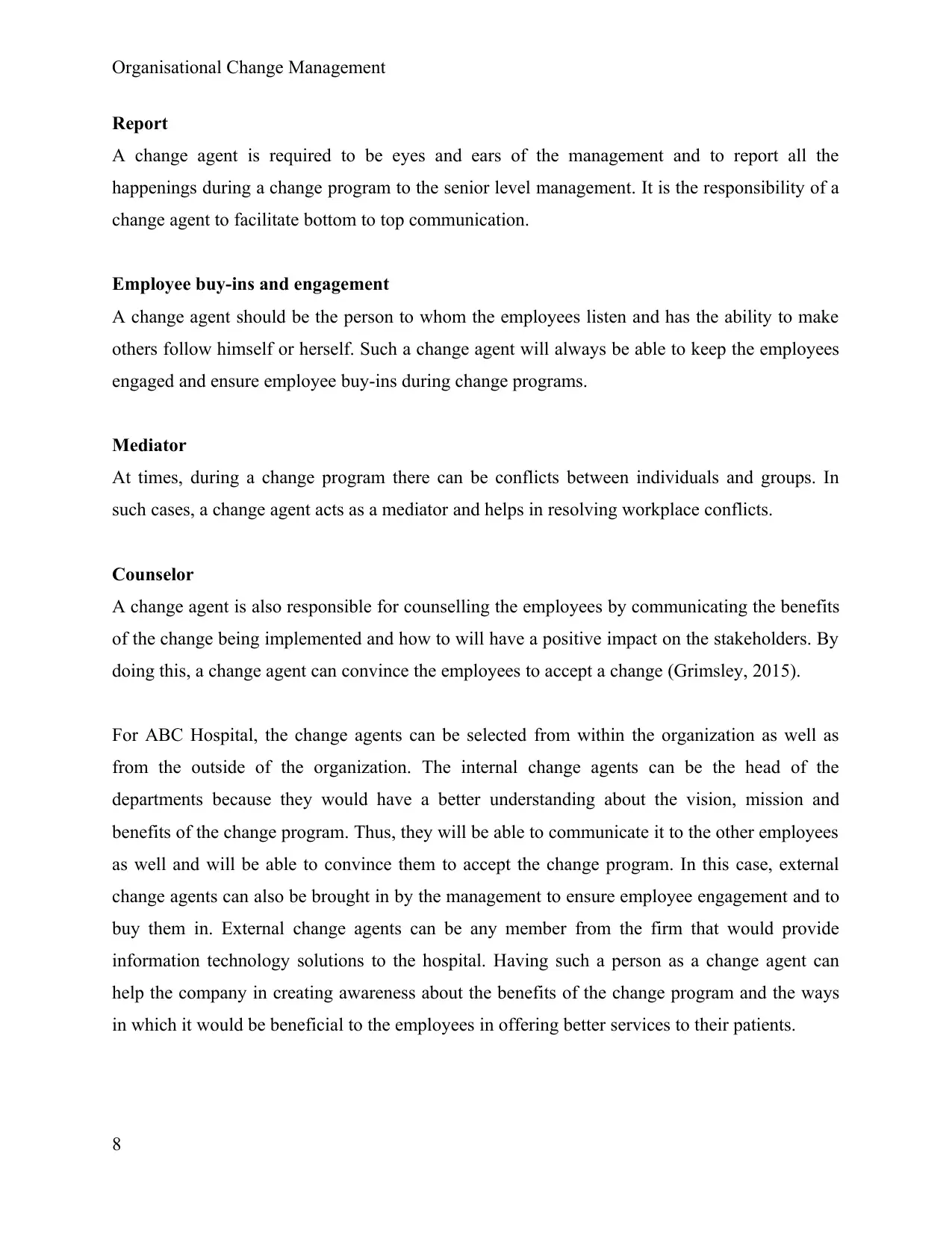
Organisational Change Management
Report
A change agent is required to be eyes and ears of the management and to report all the
happenings during a change program to the senior level management. It is the responsibility of a
change agent to facilitate bottom to top communication.
Employee buy-ins and engagement
A change agent should be the person to whom the employees listen and has the ability to make
others follow himself or herself. Such a change agent will always be able to keep the employees
engaged and ensure employee buy-ins during change programs.
Mediator
At times, during a change program there can be conflicts between individuals and groups. In
such cases, a change agent acts as a mediator and helps in resolving workplace conflicts.
Counselor
A change agent is also responsible for counselling the employees by communicating the benefits
of the change being implemented and how to will have a positive impact on the stakeholders. By
doing this, a change agent can convince the employees to accept a change (Grimsley, 2015).
For ABC Hospital, the change agents can be selected from within the organization as well as
from the outside of the organization. The internal change agents can be the head of the
departments because they would have a better understanding about the vision, mission and
benefits of the change program. Thus, they will be able to communicate it to the other employees
as well and will be able to convince them to accept the change program. In this case, external
change agents can also be brought in by the management to ensure employee engagement and to
buy them in. External change agents can be any member from the firm that would provide
information technology solutions to the hospital. Having such a person as a change agent can
help the company in creating awareness about the benefits of the change program and the ways
in which it would be beneficial to the employees in offering better services to their patients.
8
Report
A change agent is required to be eyes and ears of the management and to report all the
happenings during a change program to the senior level management. It is the responsibility of a
change agent to facilitate bottom to top communication.
Employee buy-ins and engagement
A change agent should be the person to whom the employees listen and has the ability to make
others follow himself or herself. Such a change agent will always be able to keep the employees
engaged and ensure employee buy-ins during change programs.
Mediator
At times, during a change program there can be conflicts between individuals and groups. In
such cases, a change agent acts as a mediator and helps in resolving workplace conflicts.
Counselor
A change agent is also responsible for counselling the employees by communicating the benefits
of the change being implemented and how to will have a positive impact on the stakeholders. By
doing this, a change agent can convince the employees to accept a change (Grimsley, 2015).
For ABC Hospital, the change agents can be selected from within the organization as well as
from the outside of the organization. The internal change agents can be the head of the
departments because they would have a better understanding about the vision, mission and
benefits of the change program. Thus, they will be able to communicate it to the other employees
as well and will be able to convince them to accept the change program. In this case, external
change agents can also be brought in by the management to ensure employee engagement and to
buy them in. External change agents can be any member from the firm that would provide
information technology solutions to the hospital. Having such a person as a change agent can
help the company in creating awareness about the benefits of the change program and the ways
in which it would be beneficial to the employees in offering better services to their patients.
8
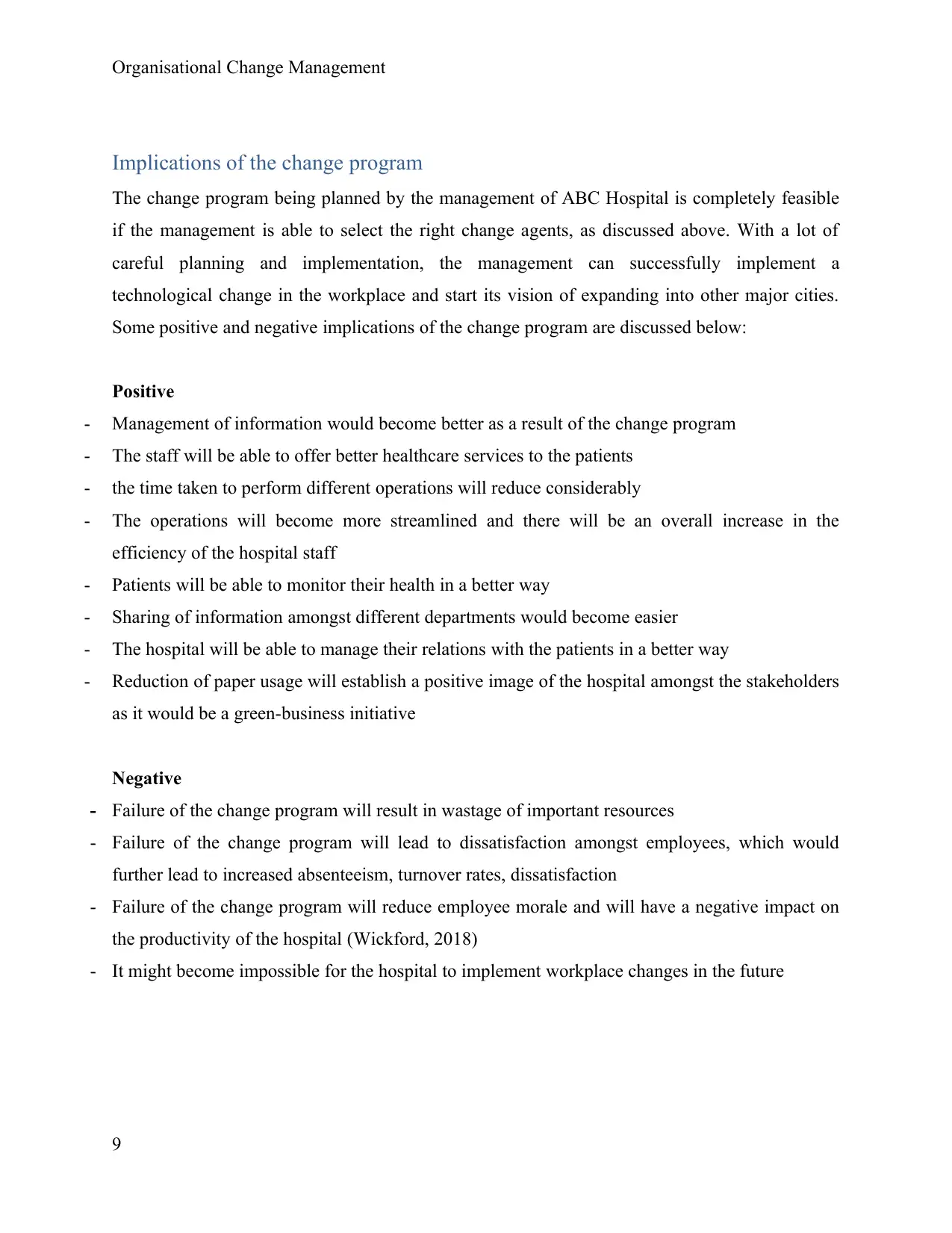
Organisational Change Management
Implications of the change program
The change program being planned by the management of ABC Hospital is completely feasible
if the management is able to select the right change agents, as discussed above. With a lot of
careful planning and implementation, the management can successfully implement a
technological change in the workplace and start its vision of expanding into other major cities.
Some positive and negative implications of the change program are discussed below:
Positive
- Management of information would become better as a result of the change program
- The staff will be able to offer better healthcare services to the patients
- the time taken to perform different operations will reduce considerably
- The operations will become more streamlined and there will be an overall increase in the
efficiency of the hospital staff
- Patients will be able to monitor their health in a better way
- Sharing of information amongst different departments would become easier
- The hospital will be able to manage their relations with the patients in a better way
- Reduction of paper usage will establish a positive image of the hospital amongst the stakeholders
as it would be a green-business initiative
Negative
- Failure of the change program will result in wastage of important resources
- Failure of the change program will lead to dissatisfaction amongst employees, which would
further lead to increased absenteeism, turnover rates, dissatisfaction
- Failure of the change program will reduce employee morale and will have a negative impact on
the productivity of the hospital (Wickford, 2018)
- It might become impossible for the hospital to implement workplace changes in the future
9
Implications of the change program
The change program being planned by the management of ABC Hospital is completely feasible
if the management is able to select the right change agents, as discussed above. With a lot of
careful planning and implementation, the management can successfully implement a
technological change in the workplace and start its vision of expanding into other major cities.
Some positive and negative implications of the change program are discussed below:
Positive
- Management of information would become better as a result of the change program
- The staff will be able to offer better healthcare services to the patients
- the time taken to perform different operations will reduce considerably
- The operations will become more streamlined and there will be an overall increase in the
efficiency of the hospital staff
- Patients will be able to monitor their health in a better way
- Sharing of information amongst different departments would become easier
- The hospital will be able to manage their relations with the patients in a better way
- Reduction of paper usage will establish a positive image of the hospital amongst the stakeholders
as it would be a green-business initiative
Negative
- Failure of the change program will result in wastage of important resources
- Failure of the change program will lead to dissatisfaction amongst employees, which would
further lead to increased absenteeism, turnover rates, dissatisfaction
- Failure of the change program will reduce employee morale and will have a negative impact on
the productivity of the hospital (Wickford, 2018)
- It might become impossible for the hospital to implement workplace changes in the future
9
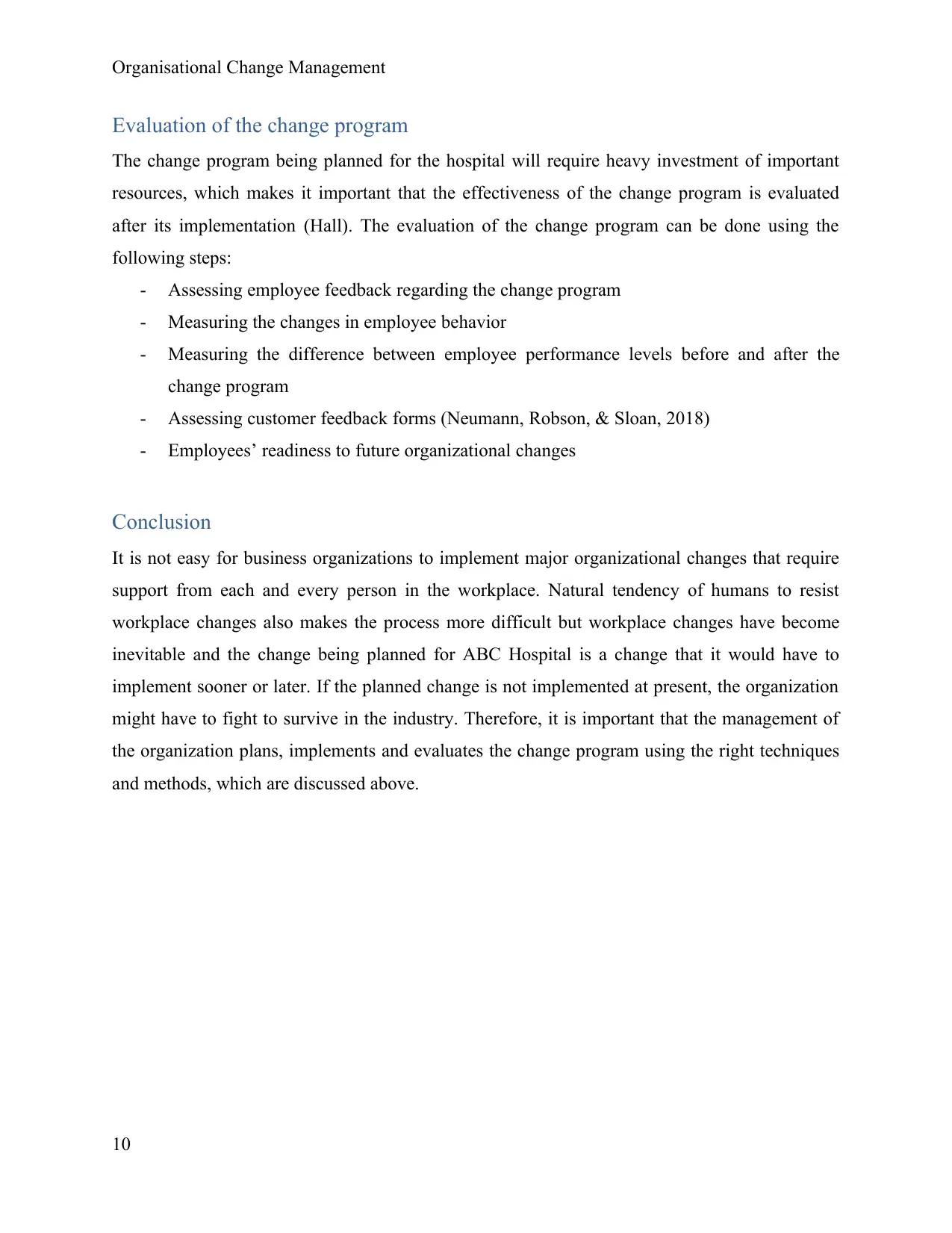
Organisational Change Management
Evaluation of the change program
The change program being planned for the hospital will require heavy investment of important
resources, which makes it important that the effectiveness of the change program is evaluated
after its implementation (Hall). The evaluation of the change program can be done using the
following steps:
- Assessing employee feedback regarding the change program
- Measuring the changes in employee behavior
- Measuring the difference between employee performance levels before and after the
change program
- Assessing customer feedback forms (Neumann, Robson, & Sloan, 2018)
- Employees’ readiness to future organizational changes
Conclusion
It is not easy for business organizations to implement major organizational changes that require
support from each and every person in the workplace. Natural tendency of humans to resist
workplace changes also makes the process more difficult but workplace changes have become
inevitable and the change being planned for ABC Hospital is a change that it would have to
implement sooner or later. If the planned change is not implemented at present, the organization
might have to fight to survive in the industry. Therefore, it is important that the management of
the organization plans, implements and evaluates the change program using the right techniques
and methods, which are discussed above.
10
Evaluation of the change program
The change program being planned for the hospital will require heavy investment of important
resources, which makes it important that the effectiveness of the change program is evaluated
after its implementation (Hall). The evaluation of the change program can be done using the
following steps:
- Assessing employee feedback regarding the change program
- Measuring the changes in employee behavior
- Measuring the difference between employee performance levels before and after the
change program
- Assessing customer feedback forms (Neumann, Robson, & Sloan, 2018)
- Employees’ readiness to future organizational changes
Conclusion
It is not easy for business organizations to implement major organizational changes that require
support from each and every person in the workplace. Natural tendency of humans to resist
workplace changes also makes the process more difficult but workplace changes have become
inevitable and the change being planned for ABC Hospital is a change that it would have to
implement sooner or later. If the planned change is not implemented at present, the organization
might have to fight to survive in the industry. Therefore, it is important that the management of
the organization plans, implements and evaluates the change program using the right techniques
and methods, which are discussed above.
10
Secure Best Marks with AI Grader
Need help grading? Try our AI Grader for instant feedback on your assignments.
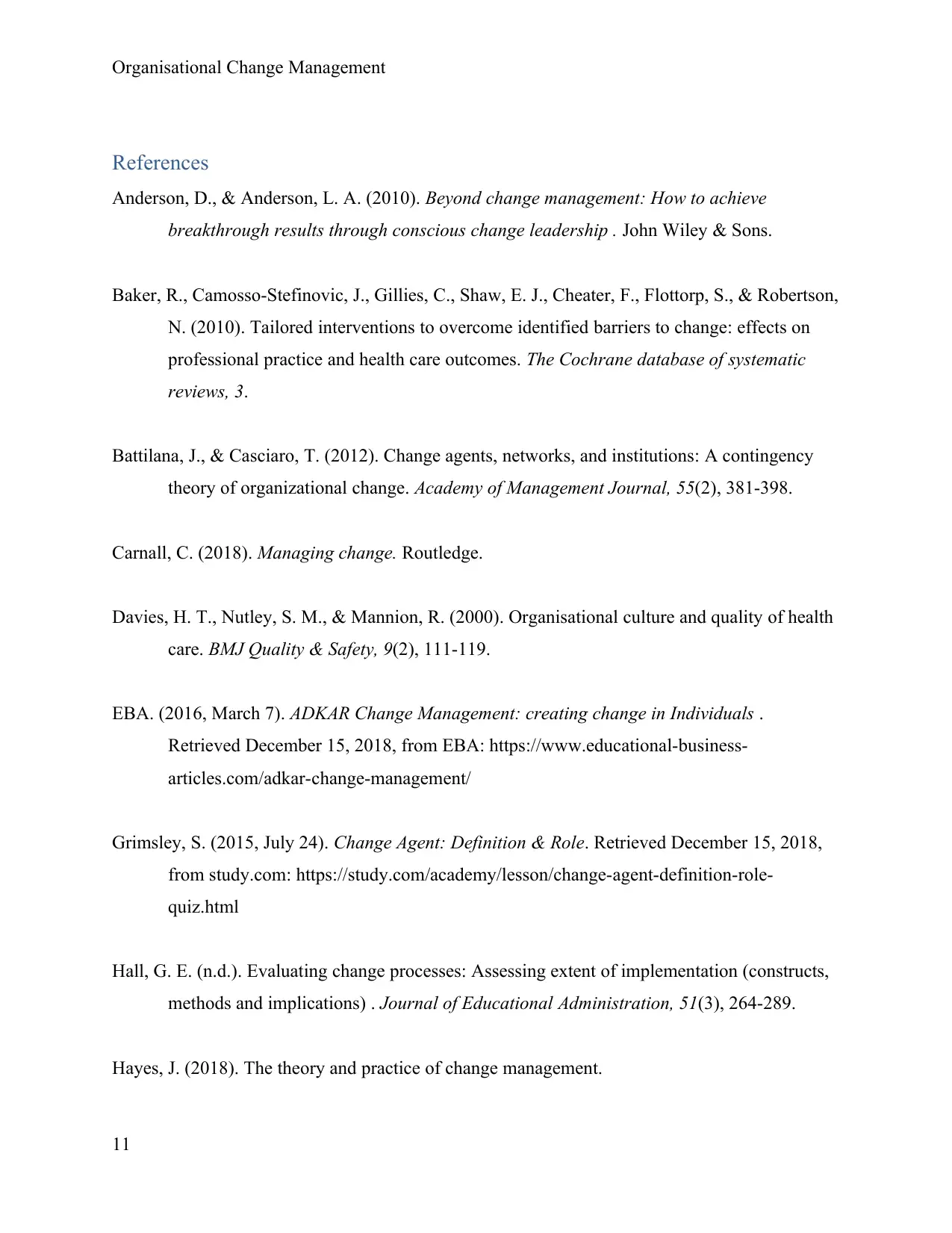
Organisational Change Management
References
Anderson, D., & Anderson, L. A. (2010). Beyond change management: How to achieve
breakthrough results through conscious change leadership . John Wiley & Sons.
Baker, R., Camosso-Stefinovic, J., Gillies, C., Shaw, E. J., Cheater, F., Flottorp, S., & Robertson,
N. (2010). Tailored interventions to overcome identified barriers to change: effects on
professional practice and health care outcomes. The Cochrane database of systematic
reviews, 3.
Battilana, J., & Casciaro, T. (2012). Change agents, networks, and institutions: A contingency
theory of organizational change. Academy of Management Journal, 55(2), 381-398.
Carnall, C. (2018). Managing change. Routledge.
Davies, H. T., Nutley, S. M., & Mannion, R. (2000). Organisational culture and quality of health
care. BMJ Quality & Safety, 9(2), 111-119.
EBA. (2016, March 7). ADKAR Change Management: creating change in Individuals .
Retrieved December 15, 2018, from EBA: https://www.educational-business-
articles.com/adkar-change-management/
Grimsley, S. (2015, July 24). Change Agent: Definition & Role. Retrieved December 15, 2018,
from study.com: https://study.com/academy/lesson/change-agent-definition-role-
quiz.html
Hall, G. E. (n.d.). Evaluating change processes: Assessing extent of implementation (constructs,
methods and implications) . Journal of Educational Administration, 51(3), 264-289.
Hayes, J. (2018). The theory and practice of change management.
11
References
Anderson, D., & Anderson, L. A. (2010). Beyond change management: How to achieve
breakthrough results through conscious change leadership . John Wiley & Sons.
Baker, R., Camosso-Stefinovic, J., Gillies, C., Shaw, E. J., Cheater, F., Flottorp, S., & Robertson,
N. (2010). Tailored interventions to overcome identified barriers to change: effects on
professional practice and health care outcomes. The Cochrane database of systematic
reviews, 3.
Battilana, J., & Casciaro, T. (2012). Change agents, networks, and institutions: A contingency
theory of organizational change. Academy of Management Journal, 55(2), 381-398.
Carnall, C. (2018). Managing change. Routledge.
Davies, H. T., Nutley, S. M., & Mannion, R. (2000). Organisational culture and quality of health
care. BMJ Quality & Safety, 9(2), 111-119.
EBA. (2016, March 7). ADKAR Change Management: creating change in Individuals .
Retrieved December 15, 2018, from EBA: https://www.educational-business-
articles.com/adkar-change-management/
Grimsley, S. (2015, July 24). Change Agent: Definition & Role. Retrieved December 15, 2018,
from study.com: https://study.com/academy/lesson/change-agent-definition-role-
quiz.html
Hall, G. E. (n.d.). Evaluating change processes: Assessing extent of implementation (constructs,
methods and implications) . Journal of Educational Administration, 51(3), 264-289.
Hayes, J. (2018). The theory and practice of change management.
11
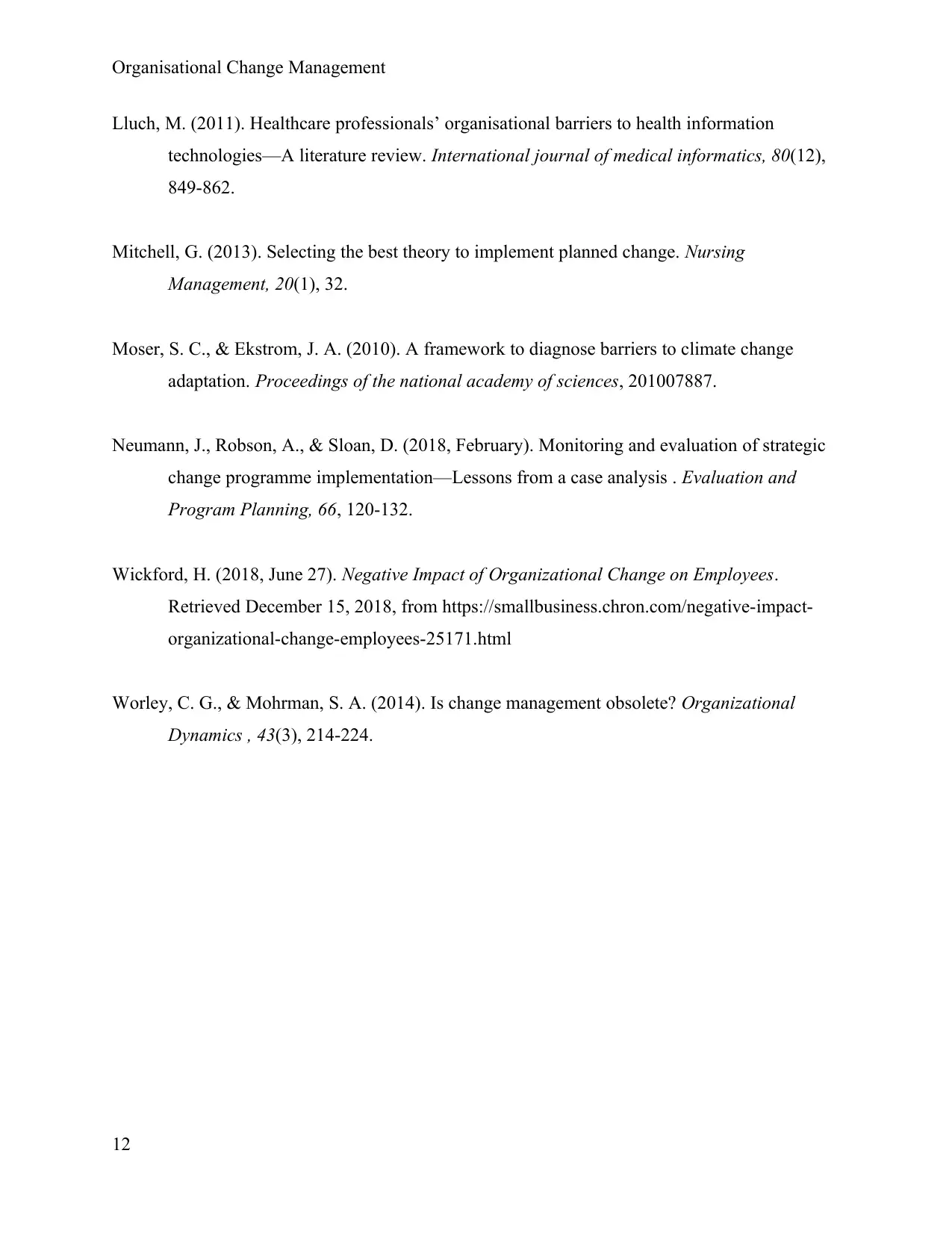
Organisational Change Management
Lluch, M. (2011). Healthcare professionals’ organisational barriers to health information
technologies—A literature review. International journal of medical informatics, 80(12),
849-862.
Mitchell, G. (2013). Selecting the best theory to implement planned change. Nursing
Management, 20(1), 32.
Moser, S. C., & Ekstrom, J. A. (2010). A framework to diagnose barriers to climate change
adaptation. Proceedings of the national academy of sciences, 201007887.
Neumann, J., Robson, A., & Sloan, D. (2018, February). Monitoring and evaluation of strategic
change programme implementation—Lessons from a case analysis . Evaluation and
Program Planning, 66, 120-132.
Wickford, H. (2018, June 27). Negative Impact of Organizational Change on Employees.
Retrieved December 15, 2018, from https://smallbusiness.chron.com/negative-impact-
organizational-change-employees-25171.html
Worley, C. G., & Mohrman, S. A. (2014). Is change management obsolete? Organizational
Dynamics , 43(3), 214-224.
12
Lluch, M. (2011). Healthcare professionals’ organisational barriers to health information
technologies—A literature review. International journal of medical informatics, 80(12),
849-862.
Mitchell, G. (2013). Selecting the best theory to implement planned change. Nursing
Management, 20(1), 32.
Moser, S. C., & Ekstrom, J. A. (2010). A framework to diagnose barriers to climate change
adaptation. Proceedings of the national academy of sciences, 201007887.
Neumann, J., Robson, A., & Sloan, D. (2018, February). Monitoring and evaluation of strategic
change programme implementation—Lessons from a case analysis . Evaluation and
Program Planning, 66, 120-132.
Wickford, H. (2018, June 27). Negative Impact of Organizational Change on Employees.
Retrieved December 15, 2018, from https://smallbusiness.chron.com/negative-impact-
organizational-change-employees-25171.html
Worley, C. G., & Mohrman, S. A. (2014). Is change management obsolete? Organizational
Dynamics , 43(3), 214-224.
12
1 out of 12
Your All-in-One AI-Powered Toolkit for Academic Success.
+13062052269
info@desklib.com
Available 24*7 on WhatsApp / Email
![[object Object]](/_next/static/media/star-bottom.7253800d.svg)
Unlock your academic potential
© 2024 | Zucol Services PVT LTD | All rights reserved.




